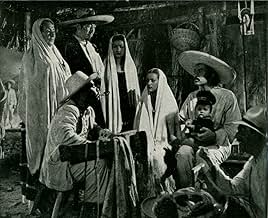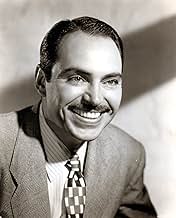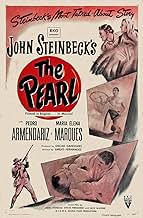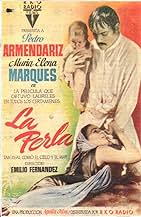VALUTAZIONE IMDb
7,4/10
1190
LA TUA VALUTAZIONE
Aggiungi una trama nella tua linguaThe discovery of a perfect pearl forever changes the lives of a poor Mexican fisherman and his family.The discovery of a perfect pearl forever changes the lives of a poor Mexican fisherman and his family.The discovery of a perfect pearl forever changes the lives of a poor Mexican fisherman and his family.
- Regia
- Sceneggiatura
- Star
- Premi
- 9 vittorie e 6 candidature totali
José Arratia
- Tratante de perlas
- (non citato nei titoli originali)
Guillermo Calles
- Indio rastreador
- (non citato nei titoli originali)
Enrique Cancino
- Pueblerino
- (non citato nei titoli originali)
Maria Elena Cuadros
- Juanita
- (non citato nei titoli originali)
Columba Domínguez
- Pueblerina
- (non citato nei titoli originali)
Enedina Díaz de León
- Yerbera
- (non citato nei titoli originali)
Agustín Fernández
- Pueblerino
- (non citato nei titoli originali)
Rogelio Fernández
- Pueblerino
- (non citato nei titoli originali)
Raquel García
- Pueblerina
- (non citato nei titoli originali)
Recensioni in evidenza
10jotix100
"La Perla", the magnificent 1947 film directed by Emilio "El Indio" Fernandez is a testament to his genius. With the help of one of the greatest cinematographers the world has ever known, Gabriel Figueroa, we are treated to a tale of hope and greed set in the Pacific coast of Mexico. Based loosely on John Steinbeck's story, the author himself, helped enhance his own story with the screen treatment.
We are introduced to Quino and Juana and their infant son, living in poverty. They are starving because the seas have been too turbulent to go pearl fishing. They almost lose the boy that is bitten by a scorpion and the village doctor refuses to take care of the infant since they have no money. The village women nurse him back to health.
When Quino and Juana go fishing, he discovers a large and shiny pearl. This pearl will be their undoing. Quino is hoping for a better life for the boy, so that he doesn't have to lead their precarious life. Fate, on the other hand, intervenes as the beautiful pearl becomes the object of desire for the ruthless dealers, and the doctor, who want to steal it from Quino.
They end up fleeing their village. In a sequence that is as cruel, as it is beautiful, we see the fishers being pursued by the dealer and his Indian searchers, and the doctor through the mangroves first, and the arid countryside later on. Unfortunately, Quino and Juana are robbed of something more precious than the magnificent pearl that has been the object of their downfall.
Mr. Figueroa's cinematography feasts on the magnificent views of the region. The film looks as good today with the excellent copy that must have been restored because it has a pristine quality. Of course, nothing would have been possible with another director because Emilio Fernandez understood the people and was able to present his story in pure cinematic terms.
Pedro Armendariz, as Quino, makes one of the best appearances of his distinguished film career. He was an actor that clearly knew his subject and understood the man he was portraying. Maria Elena Marques is right as Juana, the caring woman and mother. Mr. Armendariz and Ms. Marques gave more than life to this couple.
What seems hard to understand was the casting of Charles Rooner as the evil doctor, or Fernando Wagner, as the crooked dealer, for that matter. Both speak Spanish with a heavy French accent, something that doesn't feel right, but maybe, on the other hand, the director and the writers felt that by having foreigners try to cheat Quino and Juana set the right tone for the story.
Also, the insertion of the fiesta sequence, while lovely to look at, it seems something right out of the Ballet Folklorico and too elaborate for the conditions in which most of the fishermen lived! It's nice to have heard a stylized version of La Bamba, but somehow, it distracts from reality.
"La Perla" was a monumental achievement thanks to Mr. Fernandez's and Mr. Figueroa's inspired take on the Steinbeck story.
We are introduced to Quino and Juana and their infant son, living in poverty. They are starving because the seas have been too turbulent to go pearl fishing. They almost lose the boy that is bitten by a scorpion and the village doctor refuses to take care of the infant since they have no money. The village women nurse him back to health.
When Quino and Juana go fishing, he discovers a large and shiny pearl. This pearl will be their undoing. Quino is hoping for a better life for the boy, so that he doesn't have to lead their precarious life. Fate, on the other hand, intervenes as the beautiful pearl becomes the object of desire for the ruthless dealers, and the doctor, who want to steal it from Quino.
They end up fleeing their village. In a sequence that is as cruel, as it is beautiful, we see the fishers being pursued by the dealer and his Indian searchers, and the doctor through the mangroves first, and the arid countryside later on. Unfortunately, Quino and Juana are robbed of something more precious than the magnificent pearl that has been the object of their downfall.
Mr. Figueroa's cinematography feasts on the magnificent views of the region. The film looks as good today with the excellent copy that must have been restored because it has a pristine quality. Of course, nothing would have been possible with another director because Emilio Fernandez understood the people and was able to present his story in pure cinematic terms.
Pedro Armendariz, as Quino, makes one of the best appearances of his distinguished film career. He was an actor that clearly knew his subject and understood the man he was portraying. Maria Elena Marques is right as Juana, the caring woman and mother. Mr. Armendariz and Ms. Marques gave more than life to this couple.
What seems hard to understand was the casting of Charles Rooner as the evil doctor, or Fernando Wagner, as the crooked dealer, for that matter. Both speak Spanish with a heavy French accent, something that doesn't feel right, but maybe, on the other hand, the director and the writers felt that by having foreigners try to cheat Quino and Juana set the right tone for the story.
Also, the insertion of the fiesta sequence, while lovely to look at, it seems something right out of the Ballet Folklorico and too elaborate for the conditions in which most of the fishermen lived! It's nice to have heard a stylized version of La Bamba, but somehow, it distracts from reality.
"La Perla" was a monumental achievement thanks to Mr. Fernandez's and Mr. Figueroa's inspired take on the Steinbeck story.
Apparently this piece is uncomfortable for people who simplify into moralism its complexity and forcefulness in what it has to say both explicitly and implicitly, aspirationism for wealth and the discord and greed it provokes, bourgeois class robbery of the working class, colonialist extractionism, whiteness as a jewel that gives privilege, all this as true then as it still is, set in a melodrama full of anguish, plus of course a beautiful montage in which the photography and the masterful underwater sequences stand out, marvellous at the time and which stand the test of time with great neatness.
What can go wrong when you gather several geniuses in their respective fields: California's John Steinbeck(who later won the Literature Nobel prize), Gabriel Figueroa, Mexico's greatest movies photographer, and one of the all time greats in international cinematography, Mexico's Emilio "Indio" Fernandez??? This movie is among Mexico's greatest movies of all times. It is a story of greed and poverty(which by the way could still be a contemporary story), it is an impacting story about a poor Fisherman whose son was denied treatment by the ambitious foreign Doctor in the Village, and who later tries to steal from the ignorant Fisherman, a very valuable pearl he found in the sea. This movie was produced for RKO Radio Pictures and it was released in both English and Spanish. As an added piece of information, El Indio Fernandez, the Director, who was in platonic love with Olivia de Havilland wanted her to be the star of the picture, but more than likely this was never offered to her; So much was the love that he had for Olivia, that the street where he lived in Mexico was named Dulce Olivia(sweet Olivia) at his request. This movie was filmed in 1945, precisely during the "Golden Age" of Mexico's Cinematography.
I am a Brit happily married to a Mexicana for many years and lived in Mexico for a number of years.
La Perla is a photographic masterpiece of significant beauty and well worth seeing for the magnificence of the incredible use of natural light to highlight the scenery.
In addition to the two main stars the cast contains a number of actors whose work I have enjoyed immensely and the scenes depicting the singing and dancing at the local fiesta bring back to me countless memories of pleasure during my life in that beautiful country.
This film really does reflect the Golden Years of the Mexican Fim Industry.
La Perla is a photographic masterpiece of significant beauty and well worth seeing for the magnificence of the incredible use of natural light to highlight the scenery.
In addition to the two main stars the cast contains a number of actors whose work I have enjoyed immensely and the scenes depicting the singing and dancing at the local fiesta bring back to me countless memories of pleasure during my life in that beautiful country.
This film really does reflect the Golden Years of the Mexican Fim Industry.
This is a wonderfully shot film whose story, while not totally believable, could serve as allegory. Perhaps the family of the Mexican fisherman-diver played by Armendariz would have been happier if he had not discovered the pearl at all, but the poverty that endangers their baby's life makes his joy at this discovery (in a good underwater scene) credible. Immediately afterward, he finds himself beset by freeloaders and robbers (including his own brother), and the spiral continues until it ends in flight, hunger, death and a sort of redemption: the pearl is hurled back into the sea that spawned it. Apart from the story, the highlight is the Mexican scenery, the village and villagers, and the skillful and evocative camera angles. As one reviewer wrote, it's unlikely a villagers' celebration would have been as elaborate as the one shown in "La Perla," but it is enjoyable. Perhaps one semi-cynical message that could be gained from this film is that if you strike it rich, tell as few people as possible.
Lo sapevi?
- QuizEmilio Fernández, who was in love with Olivia de Havilland, thought she was the ideal actress to play the female starring role. De Havilland never knew of his secret love, but the director was able to get the government of Mexico City to change the name of the street he grew up on to "Dulce Olivia" (Sweet Olivia).
- Citazioni
Narrator: This is a story that old men tell to children. They aren't sure where it happened or when.
- Versioni alternativeA short version (77') was shown in the USA, France and West Germany whereas a longer version (85 to 87') was shown in Mexico and East Germany.
- ConnessioniAlternate-language version of The Pearl (1948)
I più visti
Accedi per valutare e creare un elenco di titoli salvati per ottenere consigli personalizzati
- How long is The Pearl?Powered by Alexa
Dettagli
- Tempo di esecuzione1 ora 25 minuti
- Colore
- Proporzioni
- 1.37 : 1
Contribuisci a questa pagina
Suggerisci una modifica o aggiungi i contenuti mancanti

























